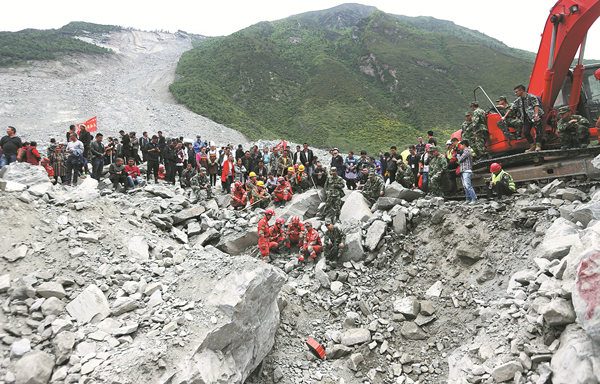
Peng Kaiqun had a sense of awe when recalling the landslide that left at least 93 people missing in her home county of Maoxian in the Aba Tibetan and Qiang autonomous prefecture in Sichuan province on Saturday morning.
“I had never witnessed anything so scary that I thought it was the eruption of a volcano,” said the 35-year-old woman, whose Lianghuokou village is within a walking distance from Xinmo village, where the landslide took place.
At around 5:38 am on Saturday, Peng said she heard a deafening sound and saw rocks falling from the nearby Fugui Mountain. “Water, mud and rocks were flying more than five meters above ground and found their way into Xinmo at the foot of the mountain,” she said.
A total of 18 million cubic meters of rock, earth and water slid from the top of the Fugui Mountain and buried 62 homes at the Xinmo village, killing at least 10 and leaving more than 93 missing, according to Xu Zhiwen, deputy chief of the Aba prefecture government, on Sunday afternoon.
On Saturday, President Xi Jinping asked relevant authorities to make maximum efforts to reduce casualties and prevent secondary disasters. Premier Li Ke¬qiang also gave instructions to the rescue work.
Family members of the missing people and those suffering losses in the disaster must be given appropriate care, according to Xi’s instruction. He also ordered the State Council, China’s Cabinet, to send a work team to the site.
On Sunday afternoon, more than 3,000 rescuers were searching for the missing in the debris. About 300 local residents had been relocated and received relief materials such as food, drinking water and quilts. Fourteen monitoring stations had been set up for the surveillance of geology, environment, meteorology and water resources, according to the prefecture government.
Liu Baolin, a 35-year-old officer of the Sichuan Brigade of Armed Police, said chances for people to survive such a landslide were slim.
People could survive a major earthquake because there was space between fallen building components, but no space was available after they were buried under mud, said Liu, who had participated in the disaster relief of the magnitude-8.0 Wenchuan earthquake in Sichuan in 2008. The quake killed more than 69,000 people and left nearly 18,000 missing.
“The landslide buried so many people because it occurred in the early morning when people were asleep,” Liu said, adding that it takes some 20 seconds at most to bury people with rocks and mud. They would soon be suffocated below a dozen meters of rocks and mud, he said.
Xu Qiang, an expert in emergency response to geological hazards of the Ministry of Land and Resources, said the landslide has something to do with the Wen¬chuan earthquake. The town is about 150 km from the quake’s epicenter.
The Wenchuan quake damaged the deep rock mass and reduced the stability of the mountain, so a landslide is more likely after excessive rainfall. Xu said it would take 20 to 30 years to get rid of the hidden risks of the Wenchuan quake within the local environment.
The site of the landslide is located along the Minjiang River, a major tributary of the Yangtze River in the upper stream, and located in the Songpinggou fault where quakes had been frequent throughout history.
A magnitude-7.5 earthquake took place there, burying the ancient town of Diexi in Maoxian county permanently under a lake and killing some 6,800 people on Aug 25, 1933.


